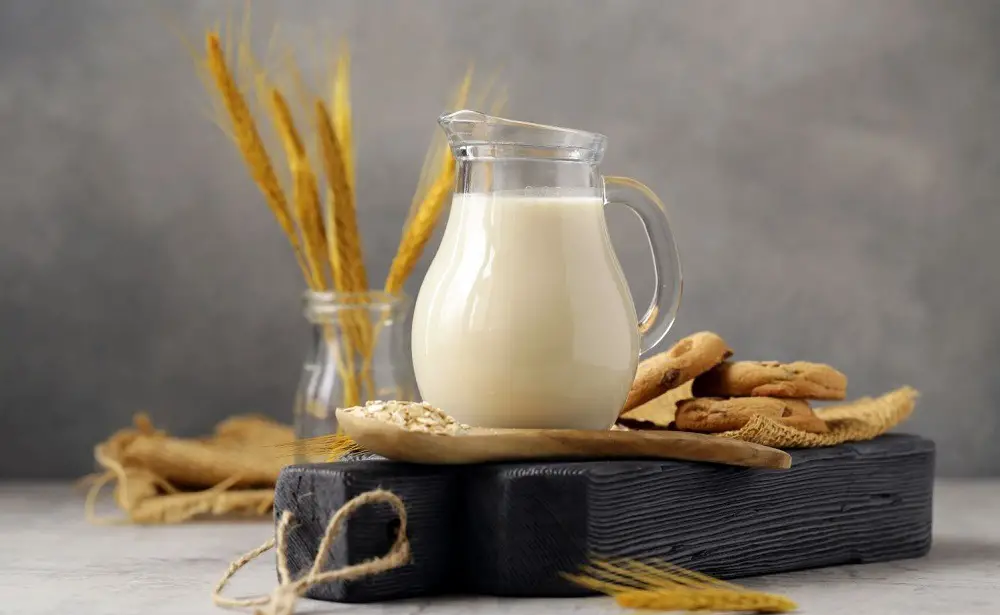Everyone is talking about oat milk! There are TickTocks about it, YouTube videos about it, articles about it (guilty as charged), but 10 years ago, you wouldn’t have heard a peep about this new non-dairy creamy drink.
Before this trend started, non-dairy drinkers would stick to soya milk. It was a drink that people went to for decades, and not long ago, almond milk was the new alpha drink. So why is oat milk taking center stage, and is its new fame as great as everyone says it is?

That question has been answered by yours truly. We’ll tell you what oat milk is and why it has bounced into the realm of popularity all of a sudden.
We have researched the trend and can tell you all the benefits and negatives you should be aware of before changing your weekly shop.
What Is Oat Milk?
Oat milk is made from oats that have been soaked in water, blended to mush, and then strained, so all you are left with is the liquid. Oats absorb water super easily, so the result is a thick and creamy texture that still contains the oats natural goodness, like it’s high fiber and high protein content.
If you were to make the oat milk yourself, instead of throwing away the strained pulp, you could use them to make oatmeal cookies or add them to your morning porridge.
Because oat milk doesn’t come from an animal, many vegans choose to use this as an alternative to cow’s milk. And because it naturally doesn’t contain any lactase, many lactose-intolerant people like to use it instead of lactose-free milk.
Some oat milks are just made from oat and water. But, like with everything, sweeteners often get added. The typical sweeteners you would find in oat milk are vanilla, dates, and cinnamon.
Originally oat milk was only available if you made it yourself, but one reason for its rapid popularity is due to companies like Oatly, Minor Figures, and Planet Oat, who have started to sell it in stores, thereby making it a more accessible and hassle-free alternative.
Why Is Everyone Drinking Oat Milk?
Because oat milk can be bought in stores, its popularity has massively increased, but that’s not the only reason for the boom.
As the years creep by, everyone is realizing that climate change is real, and although big businesses have the most sway on how our world will be affected, we can still do our bit to combat the global crisis. Oat milk is one way to cut down on CO2 emissions.
If we look specifically at Oatly’s greenhouse gas production, we can see a massive difference compared to cow’s milk with the same production rate.
Don’t worry, we aren’t going to pull out some massive graphs and talk all science-y to you (although if you want to look at the study yourself, click here). Instead, we will just give you the big figures.
Oat Milk produced 80% less CO2 emission than cows milk. They need 60% less energy overall than cow’s milk production. It can be grown in most climates, so you don’t have to create growing spaces in bio-diverse landscapes (like tropical rainforests). Oat milk uses less water than any other milk product, and it needs less land to grow the same amount of product.
If all that information was too much, then let me break it down. Oat Milk is the best milk for the environment. It is the best in almost every category. If you want to see a 5 minute YouTube video that goes into more detail, click here. If you want to read about the environmental comparisons between the top 4 milks, then skip to our “Which Milk Is Best For The Environment?” section below.
We are currently living in a generation that cares about the environment and our effect on the planet. So it’s not a surprise that when a common food item that reduces our negative impact on the world becomes widely available, it also becomes super popular.
Benefits of Oat Milk
If you’re planning to make a lifestyle change, you need to know the good and bad about oat milk. We will go into more detail about how one milk compares against another later, but let’s focus on the benefits of oat milk against no milk.
- High Amount of Vitamins And Minerals
Oats by themselves are a fantastic source of vitamins and minerals. They contain naturally found copper, folate, magnesium, manganese, phosphorus, thiamine, vitamin B, zinc, and more.
Because oat milk is simply a liquid version of oats, you will still receive all that nutrition which your body needs.
- Naturally Rich in Fibre
Oats are a fiber-rich food, which means it has high levels of carbohydrates. In fact, they are much higher than any other milk alternative, but they still contain no saturated fats, unlike cow’s milk. This means that if you want milk on your cereal for breakfast to power you throughout the day, you should use oat milk over any other.
- Naturally High in Protein
If you are vegan, getting protein in your diet can be difficult. Oat milk has high levels of protein, so you can get the nutrients you need with ease.
- Weight Loss
If you want to try and lose weight, oat milk can help you with that too. The high protein, along with the high fiber, makes you feel full for longer, which means your appetite will be more under control.
- Naturally High Iron Levels
Again vegans and vegetarians have trouble picking up all the iron they might need in their diet. If you are buying iron supplements, then it might be time to pick up oat milk instead, as it can give you 10% of your daily needs in just one cup.
You need iron in your body so that you can produce healthy red blood cells. These blood cells contain oxygen which travels throughout your body. If you don’t produce enough, you can develop an illness called anemia. Anemia is a condition of weakness and tiredness from a lack of oxygen in your body.
- Lowers Cholesterol
Oats contain “beta-glucan”, which is a type of soluble fiber. These fibers have been known to show strong cholesterol-lowering effects. The effects are still present when the oats have been turned into oat milk.
If you want to read more about the study which looked into this, click here.
Negatives of Oat Milk
There are always negatives to whatever you do in life. The hope is that the positives outway the negatives. We have found some important things to keep in mind before switching to oat milk, but hopefully, these downsides are not as problematic as they seem.
- Store-Bought Has Additives, Preservatives, and Sugars
As you can expect with anything you buy in a store, oat milk made from commercial companies is typically filled with additives, preservatives, and sugars. These don’t affect the health benefits that oat milk can give you, but buying from your local store might be a problem if you wanted to avoid these unnatural additions.
One way to avoid the added sugars and sweeteners is to buy an unsweetened version of the oat milk product.
- Oat Milk Is Technically Gluten-Free, But Some Stores Add Barley
Oats are naturally gluten-free. If you have celiac disease, we know how important it is for you to avoid any grains. Some oak milk companies try to thicken up their milk by adding wheat and barley to create an even more creamy texture.
To avoid using this cross-contaminated version of oat milk, look out for the ingredients list, search for the gluten-free certification, or better yet, make the oat milk yourself.
Which Is The Best Non-Dairy Milk?
With so many milk alternatives to choose from, it can be challenging to figure out which is the best one in general and which is the best one for you. We want to help you out by making the comparisons right here, so you don’t need to flick through different pages of promotions.
Which Milk Has The Most Nutrients?
From a 250ml glass, cow’s milk will contain around 8 grams of protein, 12 grams of carbohydrates, and 2 – 8 grams of fat, depending on if you buy skimmed, reduced-fat, or whole.
This means one glass of cow’s milk contains 15% of the protein you need for the day, 10% of the carbs, and 2 – 15% of the fat.
Using that information as a baseline, we can compare the other milks.
None of the milks have beta-glucans apart from oat milk (as we said before, beta-glucans are great at lowering cholesterol), and soy milk has tons of potassium, which none of the other milks have.
We can see that almond and oat milk have less protein than cow’s milk, but soy has the same amount. It’s also clear that oat milk has way more carbohydrates than the other plant-based milk, even enough to rival cow’s milk.
Cow’s milk has more vitamin D and calcium naturally, whereas the other milks have to add these in.
So when it comes to nutrients, cow’s milk has the most.
Which Milk Is Best For Allergies?
The answer to this question depends on your allergy. If you have a milk allergy or are lactose intolerant, then plant-based milks are best for you.
If you have a nut allergy, you should choose from dairy, oat, or soy milk.
Which Milk Is Best For The Environment?
We have touched on this before, but now it’s time to compare the milks to see which one can help us reduce our environmental impact.
Cow’s milk
Cows both need a place to live and food to be grown for them. This means they have double the amount of land necessary to create their milk. Often, the feed for the cows is grown from deforested lands.
Dairy milk uses the most water to be created. It needs about 120 liters of water per glass.
Cows produce their own greenhouse gases, just like any animal. Because of the animals and the farming equipment, each glass of dairy milk contributes over half a kilogram of greenhouse gas.
This makes cow’s milk one of the most problematic milks for the environment.
Almond Milk:
Almond Milk also needs a lot of land to be created, because almonds grow from trees in specific climates.
It also takes second place on the amount of water needed to grow the trees, requiring more than 70 liters per glass.
The greenhouse gasses created to farm the plant-based milks are about 0.1 – 0.2 kilograms per glass. It’s the same for every planet-based milk, so we will be repeating this fact to make it easier to read.
Soy Milk:
Soy milk farms are a significant driver of deforestation, and in recent years there has been a drive to lower soy farms.
Soy milk doesn’t need that much water to produce its product. It only needs about 5 – 10 liters per glass of milk.
The greenhouse gasses created to farm the plant-based milks are about 0.1 – 0.2 kilograms per glass.
Oat Milk:
Oats don’t need that much land to produce a crop, unlike the other milks.
Oat milk doesn’t need that much water to produce its product. It only needs about 5 – 10 liters per glass of milk.
The greenhouse gasses created to farm the plant-based milks are about 0.1 – 0.2 kilograms per glass.
Because oat milk is low in all the problematic issues surrounding milk production, it is widely considered the best for the environment.
Conclusion
Oat milk is the best milk for the environment, is the best milk for most allergies, and has a lot of nutritional value. So, all in all, oat milk is the clear winner.
